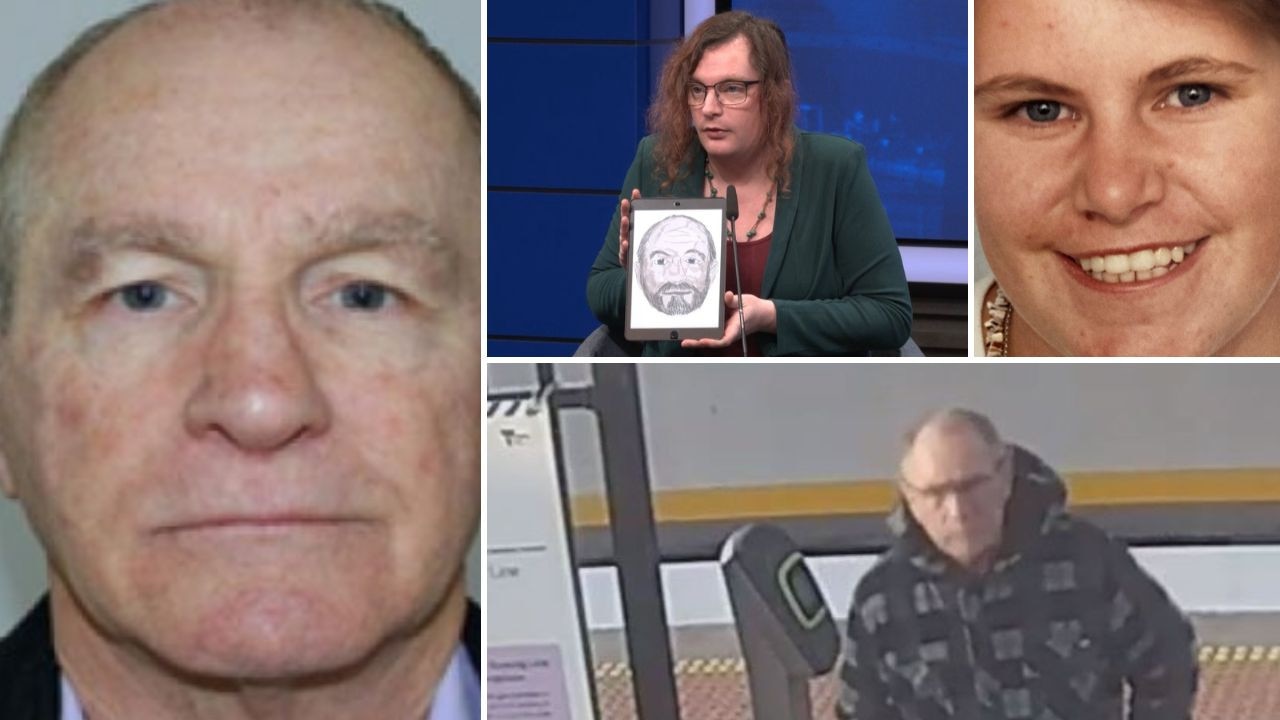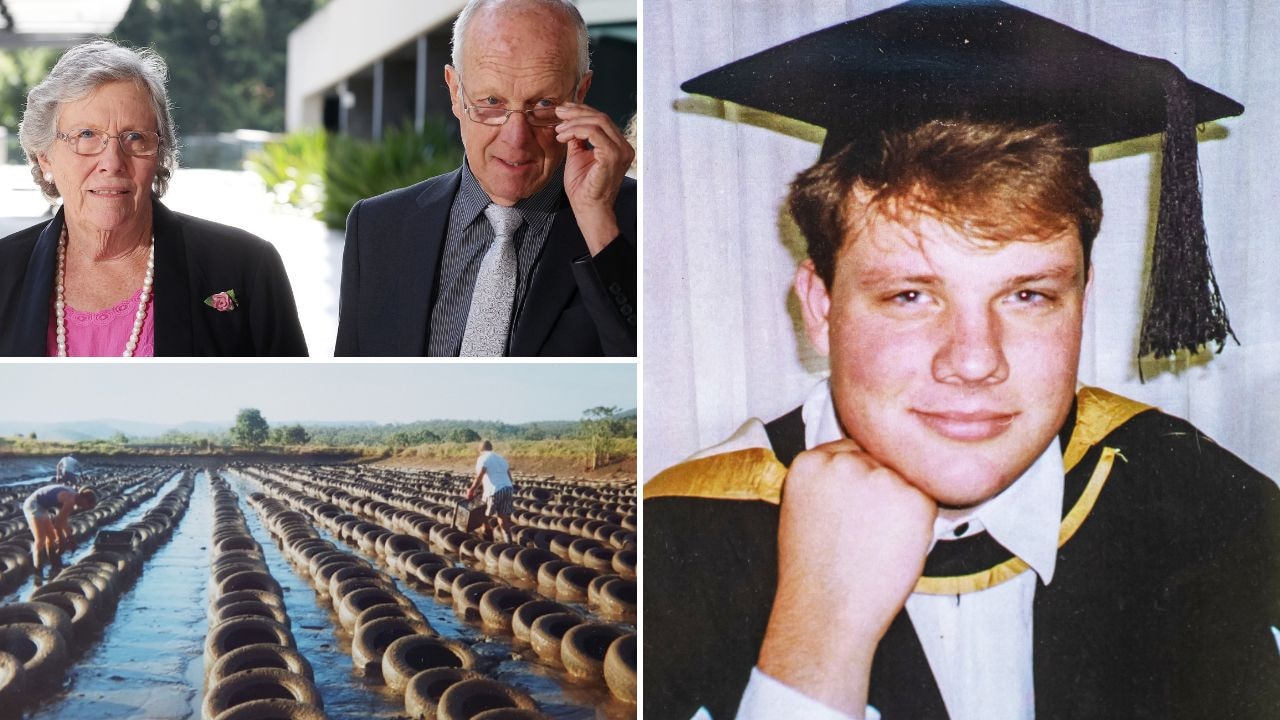New clue in mystery of slain teen runaways Fiona Burns and John Lee
SOMEBODY stabbed two teenagers to death and left their bodies at a Victorian rest stop. But does a new witness raise the awful possiblity there was a third victim of this horrific crime? ANDREW RULE PODCAST
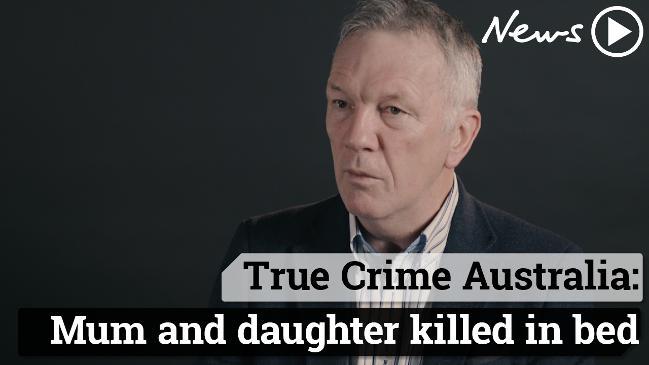
Cold Cases
Don't miss out on the headlines from Cold Cases. Followed categories will be added to My News.
WE know there was a killer on the road, one who stabbed two teenagers to death just east of the South Australian border 28 years ago.
But was there a third person, a girl with a dog, who could either be a key witness – or an unknown victim?
RELATED:
FINAL MOMENTS OF THE BLACK PRINCE
THE FOOTY STAR, STRIPPERS & THE BIKIE
THERE are two pubs in Bordertown and “Jane Black” and her partner were eating in the big one the night two teenage hitchhikers slipped inside.
They were too young to be in a hotel but Jane was more uneasy about their welfare than their age.
The bigger one was Fiona Burns, just 15 but looking old enough that the witness mistook her for moment for a former school friend.
Fiona’s travelling “mate” was John Lee, small even for a 14-year-old but a well-known face in the Adelaide street kid scene.
Jane didn’t know their names then, only that the girl with the reddish Mohawk haircut said her name was “Fiona”.
“They both looked scared,” Jane would tell Fiona’s younger sister Barbie McCarthy this month, 28 years later.
“I asked (Fiona) where she was from. She told me ‘Melbourne’. She also told me she was going back home.”
The friendly local, then 25, then asked if they needed help and Fiona said something Jane never quite forgot.
“She told me ‘You don’t want to know’.”
She got the impression from what the pair said that someone was after them.
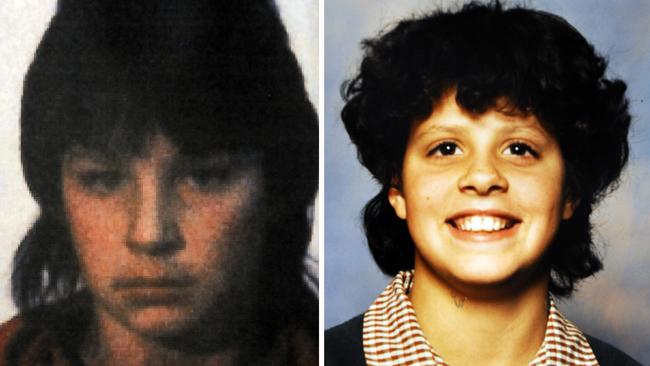
Jane suggested they ring the police. They didn’t. But they did go upstairs to stay out of sight of whoever it was they were nervous about.
When Jane left the hotel, she says, she saw “six guys” she thought might have been “looking for them”.
That was just a guess. But someone did find them.
A week later, the teenagers turned up dead a little way east of town, just over the Victorian border.
Jane was never sure that she’d seen anything worth reporting.
Early this year, she finally contacted Victorian police about the troubling thing she’d sensed that night in early October, 1990.
Two weeks ago she got in touch with Fiona’s sister after hearing about the case on a true crime podcast that awakened memories.
Investigators would have to treat her with caution but at least it gives them a couple of threads to follow on a trail long gone cold.
It also gives them a couple of names.
One belongs to a man who is still alive and sometimes says he knows what happened to the murdered pair. The other belongs to one of his associates, whose life ended a year after the double murder.
THE couple who found the bodies had pulled over to collect gum nuts next to a truck parking bay on the morning of October 18, a Thursday.
Fiona’s body was face down among some trees beside the parking bay. When the police turned up they found John Lee’s body about 50 metres away.
Both had been stabbed.
When Melbourne homicide detectives arrived after their 400-kilometre journey to the state’s outer edge, they concluded the kids had been killed elsewhere.
There were no obvious blood splashes or signs of struggle at the scene.
The last time the pair were seen alive was between 10pm and midnight on October 10, when Fiona — distinctive with her Mohawk haircut — had knocked on a truck window at a truck stop outside Bordertown and asked a driver for a cigarette and a ride to Melbourne.
He told police he’d refused and hadn’t seen them again.
That the bodies were a week in the open, unprotected from crows, animals and flies, didn’t help the police hunt for clues.
As usual, speculation and rumour filled the gaps in the story. All that was known about Fiona was that she had run away from home in Melbourne — not for the first time — and arrived in Adelaide in late September.
Fiona was the oldest of three children to John Burns and his estranged wife, later known as Linda Miaris.
The two younger children, Barbie and Ricky, stayed with their mother in Langwarrin but Fiona wanted to live with her father.
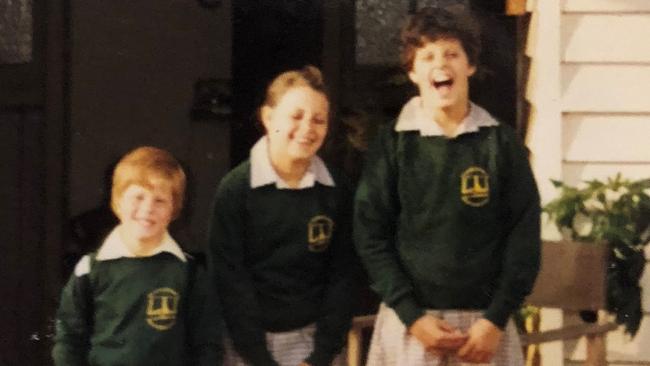
It didn’t work out, so Fiona moved into a caravan in the rear of her aunt’s house, also in Langwarrin.
After an argument with a friend, she had caught the train to Adelaide, leaving a note saying “thank you, love you all, I’ll be right”.
Why she chose Adelaide isn’t clear, apart from the obvious conclusion that it is the closest capital city to Melbourne and therefore quicker and cheaper to reach.
Fiona had just turned 15 on August 4.
A sign of her confusion and unpredictable behaviour was that she returned to Melbourne to her father’s house after just five days, saying street life wasn’t what she thought it would be.
But she stayed with her father only long enough to have a sleep, a shower, and do her washing, then headed back to Adelaide.
READ MORE:
DID KILLER HAVE FRIENDS IN HIGH PLACES?
STILL HAUNTED BY A LITTLE GIRL LOST
SUBSCRIBE TO ANDREW RULE’S PODCAST ON iTUNES HERE AND RSS HERE
It was on this trip that she befriended John Lee, also known by the nickname “Jazz”, a street kid who had grown up in Mt Gambier and had washed up in Adelaide two years earlier to skate the thin ice between the streets and Government care homes.
One of his contemporaries to make it to adulthood — many didn’t — is Maggie Taube, who still recalls the tiny John Lee as a beggar and thief “but still just a kid”.
Taube, now a youth worker, confirms the Burns family’s version of events — that Fiona was more a “tourist” runaway than a “real” street kid, most of whom were wards of the state who had long ago been abandoned or neglected by their families.
Fiona, by contrast, was the oldest three children of a hardworking couple who had split the previous year after running businesses around Victoria.
Pictures of the children in their school uniforms show them as normal, healthy, happy kids. Life would probably have returned to normal if Fiona had survived her rebellious phase and come home safely.
But she didn’t. Somewhere near Bordertown, she and John found a killer or a killers.
But who?
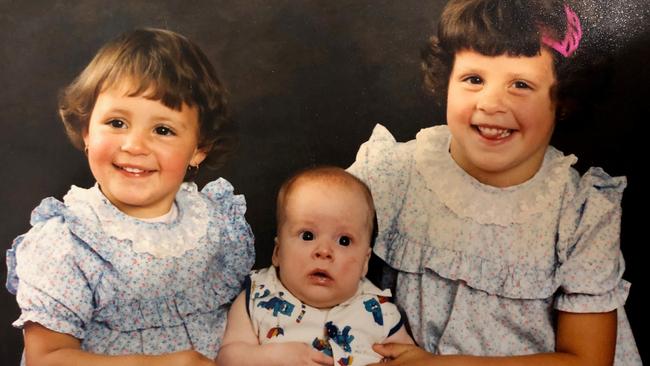
MAYBE they just came across a bad truckie,” suggests Maggie Taube, the former street kid who survived years of living dangerously and is now a mother and a youth worker, helping others duck mistakes she made herself.
“A lot of truckies carried speed and other drugs and maybe they tried to rob one and he turned on them.”
She says the theft scenario fits because some of the street kids had suffered sexual abuse or physical abuse and neglect and preferred to beg and steal than to stay in government care homes.
“I’d see John Lee in Hindley St or Rundle Mall, scabbing money to buy cigarettes or a flagon of wine or some dope,” she recalls. “He was a serious street kid but not a fighter. He was very short and pretty quiet.
“We had paedophiles hanging around. We used them to get stuff and there were reports of child prostitution but I saw no sign of that with John. Fiona and John would go off together, disappear then come back.”
RELATED CONTENT:
BILLY ‘THE TEXAN’ LONGLEY UNDERWORLD GENERAL OF MELBOURNE WATERSIDE
WHEN AN ENTIRE VICTORIAN SCHOOL WAS KIDNAPPED — TWICE
NOTORIOUS PAEDOPHILE PRIME SUSPECT IN LITTLE JOHN LANDOS DISAPPEARANCE
Maggie believes the pair had planned to take a suburban train to the outskirts of the city then hitchhike. But because other street kids had intended to go with them they “didn’t front” at the railway station because they knew it would be too hard to hitch with more than two.
“So they took a bus out of town then hitched.”
What no one knows for sure is what day they left. Fiona had sent her father a letter that gave the impression she was leaving Adelaide on October 9 and had “a surprise” for him — probably referring to the fact she had John with her.
But there is no proof she left Adelaide on that specific date. Her sister Barbie says it is quite believable they left a day or two earlier and had been in the Bordertown district for 24 hours — or even longer — before their deaths.
This tallies with Jane Black’s belief they fell into bad company in the district.
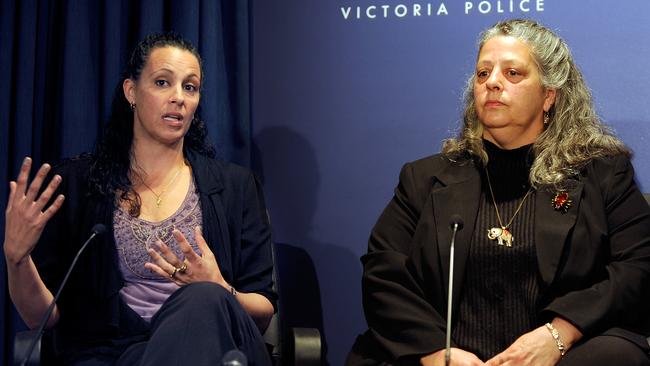
Jane is not what homicide investigators consider an impressive witness but she knows what she saw on the night she met the two twitchy kids.
She says she saw a group of six young men, two of them known to her by name.
One that the Sunday Herald Sun has chosen not to name was in a white Holden station wagon the two teenagers might have been seen in some time before they vanished.
The other local man was a Robert Rackebrandt, who lived in the lonely hamlet of Warriga on the Adelaide side of Bordertown.
In 1990, Rackebrandt was 32, a drifter who drank and used drugs and fathered several children and worked in dead end jobs. He was slightly built and tattooed and “strange”, according to Jane Black.
To her, Rackebrandt and the station wagon driver and their four mates seemed a little threatening on the night Jane saw them roaming Bordertown’s main street.
She spoke to one of the men, who told her they were planning to go “bunny bashing”, a local sport involving spotlighting rabbits and clubbing them. They invited her to go with them and she declined, saying she had to put her daughter to bed.
When she got home she turned her two dogs loose in the yard in case the men turned up. Something about them worried her.
One of them, she recalls, worked on the slaughter line at the local meatworks, and was an expert with knives.
And Robert Rackebrandt? He was shot dead a year later, in mid-October 1991.
A coroner ruled that it was suicide but his family have their doubts. They believe the gunshot wound might not have been self-inflicted.
Suicide because of a guilty conscience? Or murder to silence a loose tongue?
Either way, it happened on the week of the first anniversary of the murders. It could be coincidence.
There is a postscript.
Mrs Patrica Plozza of Kaniva got in touch with the Herald Sun in 2018 after seeing the story about the last known movements of Fiona Burns and John Lee and the subsequent discovery of their mutilated bodies.
Mrs Plozza is now a great grandmother in her late 80s but she is alert and has a sharp memory. She recalls that just after midday on October 10, 1990, she was driving west to Bordertown to see her daughter and grandchildren.
She is sure of the date because she made two purchases by cheque that day and has kept the cheque butts. And she knows she went during the lunch hour because she was wondering if some shops would be shut for lunch when she got to Bordertown.
She was driving about eight kilometres west of the clump of trees where, a week later, the bodies would be found when she saw three people walking towards her at a point where a track used to join the highway.
She saw a teenage boy, small with straight hair, in dark clothes. This matches the description of John Lee. She saw a teenager girl with “orange” hair she describes as being cut short at the sides, another way to describe the Fiona Burns “Mohawk” that other witnesses saw.
But the curious grandmother also saw another young woman leading a dog, which was pulling on its leash. It was a long-haired, light-coloured dog of medium size – maybe a collie cross. It was obvious to Mrs Plozza the three young people were walking together, heading east, deeper into Victoria.
It is clear the boy and the girl with the orange hair were Fiona Burns and John Lee, the two later murdered later that night. But who was the girl and her dog and what happened to her? Did she accept a separate ride and go off into the night, oblivious to the fate of her temporary companions -- in which case you’d think she might contact police after news of the murders broke.
Or did the girl with the dog vanish too? Was she the last to see Fiona and John alive – therefore perhaps knowing what sort of vehicle the other doomed pair got into, if that’s what they did? Or was the dog lover a third victim, one never missed or found or identified? Another loose end in another cold case.
Originally published as New clue in mystery of slain teen runaways Fiona Burns and John Lee


